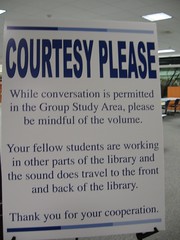It was a wide ranging talk about preparing your library, staff and users for the kind of hyperlinked environment in which we now exist. There was one theme from the presentation, however, that particularly interested me and which this blog post is about.
Several times in the presentation Michael used the phrase, "Libraries tell stories". What he was talking about was that whether we realise it or not the physical and digital spaces our libraries occupy, along with the decisions we make about what our users can and can't do in those spaces, send messages to the people who come to use them. Take a look at this photo from his presentation - go click on it and read the comments on Flickr.
There were a bunch of similar examples and what he was really talking about was what kind of experiences are we providing for people who visit the library, whether that be the physical library or our digital presence. There was another example in the talk (and forgive me if I get the details slightly wrong) where a customer at a store in the US went into a change room to try on some clothes, only to find that the change room was a mess with a heap of clothes piled up in the corner. The customer took a photo of the mess with their mobile and uploaded it to Flickr. Within a day it made a major newspaper!
It's often quoted that customers who have a bad experience talk about it to 10 times the number of people than do those who have a good experience. I don't know about the numbers but I do know that the connectedness of the digital environment makes it easier than ever before to spread the word quickly. Can you imagine a situation in your Library where a user takes a photo or video on their mobile phone of a bad experience they have and shares it with all their friends via Flickr, YouTube, Facebook or their blog?
The examples of negative stories that Michael used in his presentation all come from well meaning libraries that were trying to create an environment that benefits all their users, but who had lost sight of the bigger picture. It reminded me of the idea of the Tyranny of One, an idea first drawn to my attention from another blog post in which a library director discusses her library's review of policies and practices. She states:
...in many cases we have implemented policies and practices because of the minority of people who do the wrong thing, and in the process make things more difficult for the majority who do the right thing...When we put up a sign or make new rule are we doing it for the benefit of our customers or for the benefit of the library staff? What kind of stories are we telling our customers? Consider the following example as a comparison with the sign above.
David Lee King discusses customer experience regularly in his blog and I strongly encourage you to have a read if this area interests you.
At the start of this post I suggested that Michael Stephens was one of the foremost writers and speakers about Library 2.0. What he is saying here is the essence of Library 2.0. Library 2.0 is not just about adding Web 2.0 tools and technologies to libraries. The technology is just a means to an end and the end is that we need to be telling better stories and providing a better experience to our users.
This is why we are running a Learning 2.0 program at my library. It isn't because we want the Library to have a YouTube account, gather friends on MySpace and look cutting edge. The program is running to allow staff to get an understanding of the hyperlinked environment in which libraries now exist.
The skills gained as a result of Learning 2.0 are just there to allow library staff to tell better stories to their customers in new ways and in new places.

